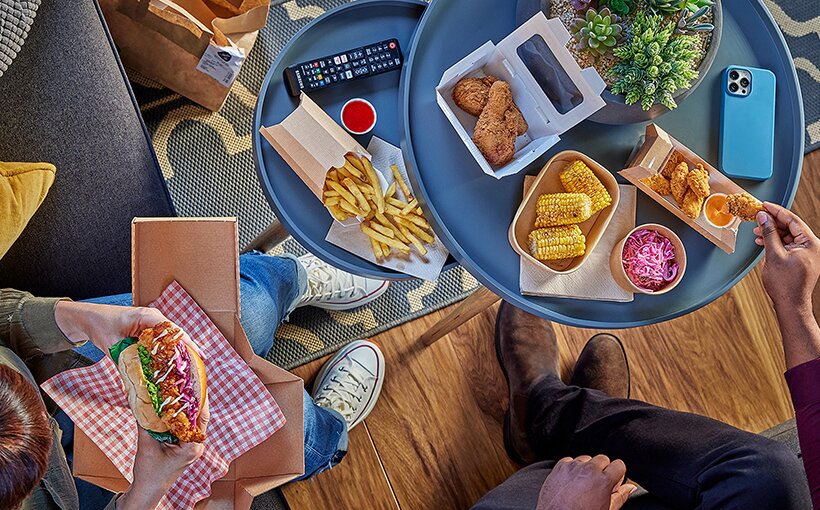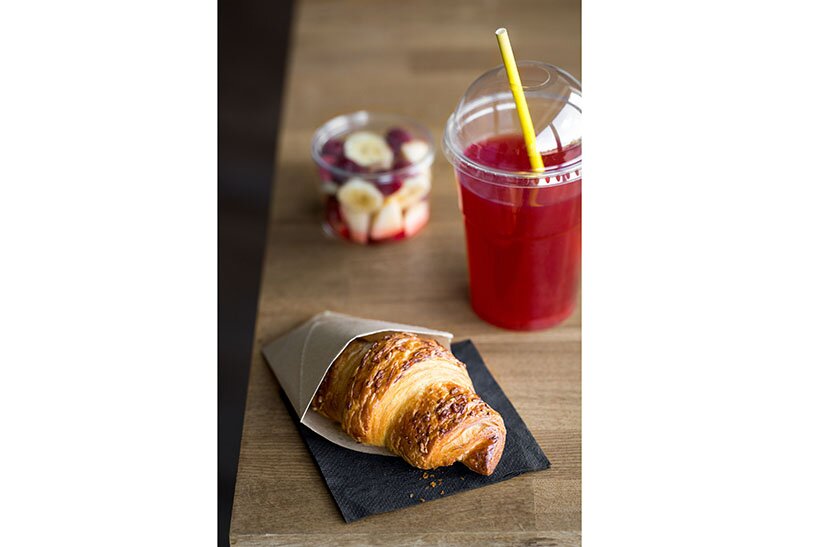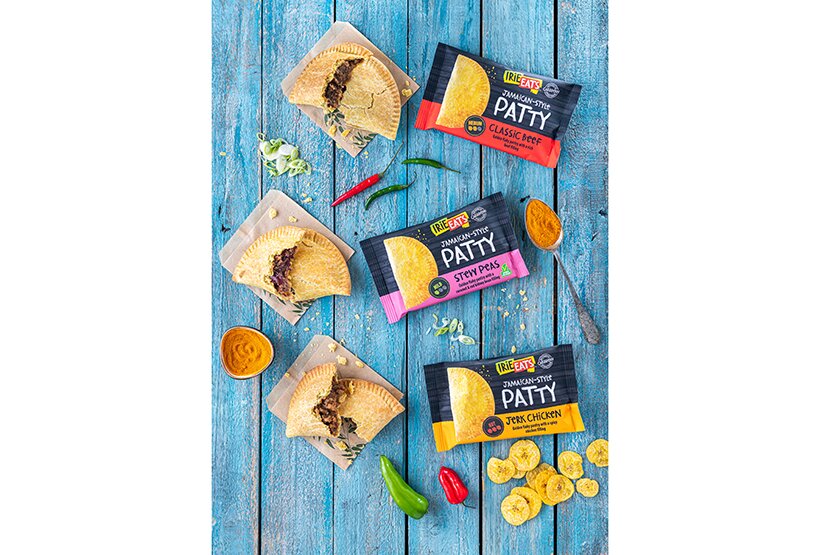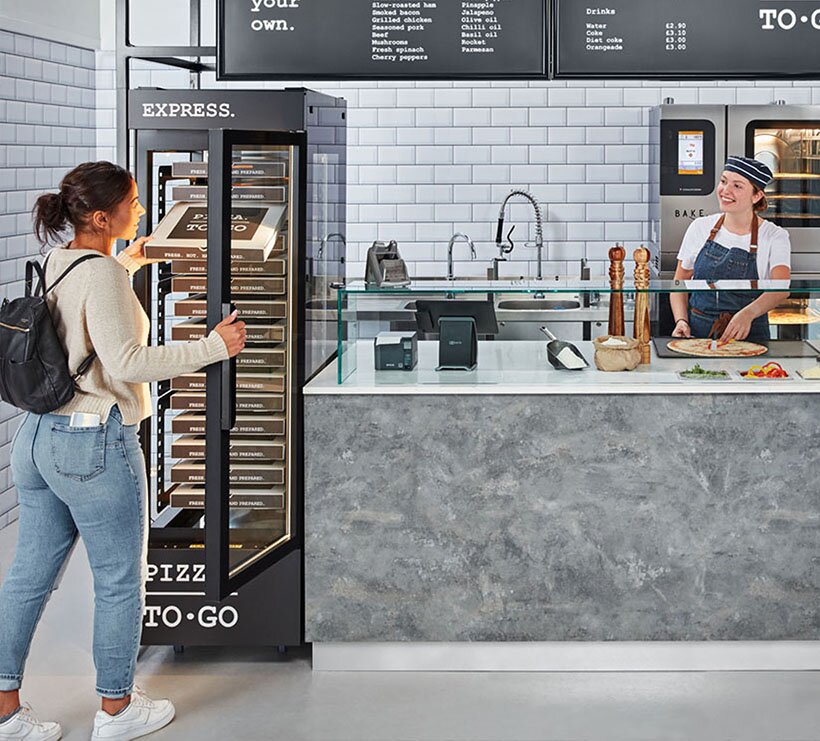Take your grab and go offering to the next level
For customers on the run, grab-and-go is a perfect provision. Ian Boughton looks at how to make sure your offering isn’t sad and stale
The term ‘grab-and-go’ used to conjure an image of low-quality takeaway food for workers on the run, sold by corner stores and rail stations. Now convenience food has upped its game, delivering high-quality fare at profitable selling prices – so much so that even top operators of hotels and restaurants have seen an opportunity for themselves.
But there is a vital difference between ‘takeaway’ and ‘grab-and-go’, with the latter implying the food on offer is already ‘finished’ in terms of preparation, and the customer simply picks it up, pays and leaves. The new questions are: foods can be offered as grab-and-go, and how can they be displayed for easy-grab?
Restaurant Associates noted its venues have done well from an expanded range of grab-and-go items, such as gourmet pies, salad pots, sushi boxes and filled bagels. Following a survey, it concluded grab-and-go sales are particularly up among workplace consumers, with increasing numbers of workers spending more money, more often. They demand availability of grab-and-go throughout the working day, and this is an opportunity for all caterers in B&I settings. The problem is maintaining quality in food that may be on display for some time.
“Food has a flavour arc,” says Restaurant Associates culinary director Adam Thomason. “Every taste or dish has a peak point – the aim is to always have that item at the top of the peak.”
Because working habits have evolved beyond nine-to-five, grab-and-go offers must be available for longer periods, agrees Peter Kent, regional managing director at BaxterStorey – and grab-and-go payment is changing, too. The caterer has experimented with Amazon’s ‘just walk out’ technology concept, in which customers log in when entering a catering site, the system identifies what they pick up, and they are charged via their Amazon account.

Pay and display
Bakery business Bridor says attractive pastries now work well for grab-and-go if the operator prepares in advance for a display to be restocked during the day with quickly baked-off items. Typically, its cheese finger puff pastry snack can be displayed at room temperature, and its pastel de nata, a Portugese pastry with a caramelised taste, is said to ‘last all day’ when stored under a light cover. The same, says sales director Erwan Inizan, applies to croissant, pain au chocolat and pains aux raisins – Viennese pastries are particularly good sellers for grab-and-go.
Pastries, Italian breads and Viennoiserie are all real opportunities for this kind of takeaway business, agrees Rebecca Calveley, marketing manager at La Lorraine.
“Above all, grab-and-go customers now want quality. They want products that look great, smell great and taste great. Our Panesco Caruso potato mushroom is a perfect convenient hand-held snack and looks truly sensational – this eccentric hand-folded bow-shaped pizza base catches the eye of the consumer and offers the taste of a fresh pizza while keeping its flavours for longer.”

Spice of life
The grab-and-go market is showing an increase in demand for salads and wraps, and also for hotter and spicier taste profiles, notes Phil Carratt, head of marketing at Country Choice. He sees more operators devising more grab-and-go meal deals aimed at different sectors of the market – some for health-conscious consumers, others for students, and so on.
“Many Asian cuisines are particularly suitable for grab-and-go because they adapt well to takeaway and transport requirements without any adverse effect on the food,” suggests Greta Strolyte, brand manager at Lucky Boat. “Japanese, Thai and Korean are among the current top trends”.
Noodle dishes also work well, she suggests, noting how pre-prepped noodle salads can be displayed for a similar time as a sandwich, and look more interesting.
So does Mexican, says Barnaby MacAdam, taste creator at Santa Maria. Because wraps form a convenient foundation for takeaway dishes, sales have increased by 38% year-on-year, he says. His Mexi-Go range of downloadable food-to-go recipes offer operators ‘finger-licking opportunities’ for pre-prepping grab-and-go items based on classic Mexican hand-held snacks, and even a fish and chip burrito.
“Burritos and wraps, quesadillas, tacos and taquitos can all be the base for dishes across any day part from breakfast onward,” he says.
Jamaican grab-and-go is another relatively new idea. “Global cuisine is now a leading segment of grab-and-go,” says Tom Styman-Heighton, development chef at Funnybones. “International twists on familiar favourites are a great idea – rather than a standard Cornish pasty, operators can mix up their offering with Jamaican patties.
“The Jamaican patty is a grab-and-go icon in the streets of Kingston. You can always tell it from its sunshine gold appearance, which is created by the turmeric in the flaky pastry. Heat levels are mild, medium or hot, and ours are individually wrapped and frozen, to be heated and then displayed in the hot cabinet.”

Hot and cold
Keeping things in that takeaway cabinet is a major consideration, as Flexeserve is quick to advise. Certain foods have long been difficult to hold in traditional grab-and-go displays – bread products either dry out or go moist, soups and stews develop a skin, delicate products such as pastries do not always survive, and eggs are a whole problem by themselves.
“Most hot-holding solutions on the market don’t actually deliver hot-holding,” explains director Warwick Wakefield. “They continue to cook the food, resulting in poor quality. Their methods are inefficient, using power-hungry heating elements reaching excessive temperatures… so, the hot food that could be offered as grab-and-go has been restricted to bland, uninspiring, unhealthy items.
“But ‘true’ hot-holding has changed all that,” he says, explaining that convection technology is needed to keep a wider range of hot food at optimal quality. “And Flexeserve’s unique technology delivers true hot-holding in maintaining the just-cooked quality of hot food products that can now be displayed for unrivalled hold times.
“Almost any dish can now be served easily as grab-and-go, so operators can unlock options that span all dayparts, from soft and springy breakfast sandwiches and protein pots with soft poached eggs, to delicate pasta and rice dishes, soups and stews for lunch, to warm bakery and sweet afternoon treats. With this technology, you use hot air to your advantage, so poached eggs remain soft for four hours.” He adds: “The ultimate hot-hold challenge is French fries. And ours stay crisp for two hours.”

Now it is accepted that cooked food can be kept in good condition, imaginative ideas are coming in, says Scott Kedwards, development chef at Panasonic: “Breakfast is probably the number-one area where you need this type of product – bacon rolls, sausage rolls, pizza slices and pastries. By using our technology, operators are now able to have these products at their best for longer, without drying out,” he says.
“We have now seen a move by some operators to using bento-style boxes with separate compartments to serve different items, like sausage and scrambled egg. These are becoming more popular, and so long as the packaging can withstand temperatures, once cooked, they are great ideas for grab-and-go. Porridge pots are similar, as a convenient and hot on-the-go breakfast choice.”
But not all grab-and-go offers are hot, notes Malcolm Harling, marketing director at Williams Refrigeration. Cold and chilled food holds its own problems in terms of keeping peak quality.
“One of the key issues with conventional grab-and-go merchandisers is that they lose their cool. Cold air falls out of the unit, increasing energy use, creating a chilly environment for customers, and compromising internal temperature and food safety,” says Harling.
“Our latest open-fronted Gem Multidecks maintain the interior thermal envelope, thanks to a curtain of cold air drawing down over the front of the unit. Units with doors can deliver further substantial improvements – hinged doors help decrease energy requirements by up to 60% compared to the open-front equivalent, while clear double-walled glass provides excellent product visibility.”
And that visibility is key, says Nick Pendlebury, director of Pantheon Catering Equipment. A well thought-out display will also help your upselling, if you keep your add-on items close to your main offers.
“In grab-and-go, your visual display is a far stronger draw than your menu.”
Label maker
The labelling of grab-and-go items has recently come in for close scrutiny. Brother has done a lot of work on this, and observes that 54% of pre-packed food for direct sale fails to declare accurately the presence of allergen ingredients – much of the reason, says Brother, is that many grab-and-go labels are still handwritten, and illegible due to poor handwriting and patchy printing. This leaves caterers at risk, and Brother has produced an E-book based on Natasha’s Law (the rules on allergen labelling), which suggests labelling technology can make compliance easier.
While labelling is not legally required for some takeaway situations, Brother says doing it properly shows how serious an operator is about serving customers with special requirements. Easy printing technology allows the operator to not only make allergen warnings distinct, maybe with big and bold lettering and a brightly coloured label, but to add their own creative marketing content.
Labelling has become easier and far more useful and detailed, agrees Gareth Newton, managing director of BGL Rieber. “The Rieber Eatainable system features stick-on QR-coded labels that identify the food, the size of the container, the customer, the time, the date, etc. To prove HACCP, the labels can even record the temperature at which the food was sold.”
Suppliers
BaxterStorey www.baxterstorey.com
BGL Rieber www.bglrieber.co.uk
Bridor www.bridor.com/en-uk/
Brother www.brother.co.uk
Country Choice www.countrychoice.co.uk
Flexeserve www.flexeserve.com
Funnybones www.funnybones.co.uk
La Lorraine www.lalorraine.com/gb-en/professional
Lucky Boat www.luckyboatnoodles.co.uk
Panasonic www.panasonic.com/uk
Pantheon www.pantheonce.co.uk
Restaurant Associates www.restaurantassociates.co.uk
Santa Maria www.santamariaworld.com/uk
Williams www.williams-refrigeration.co.uk




















